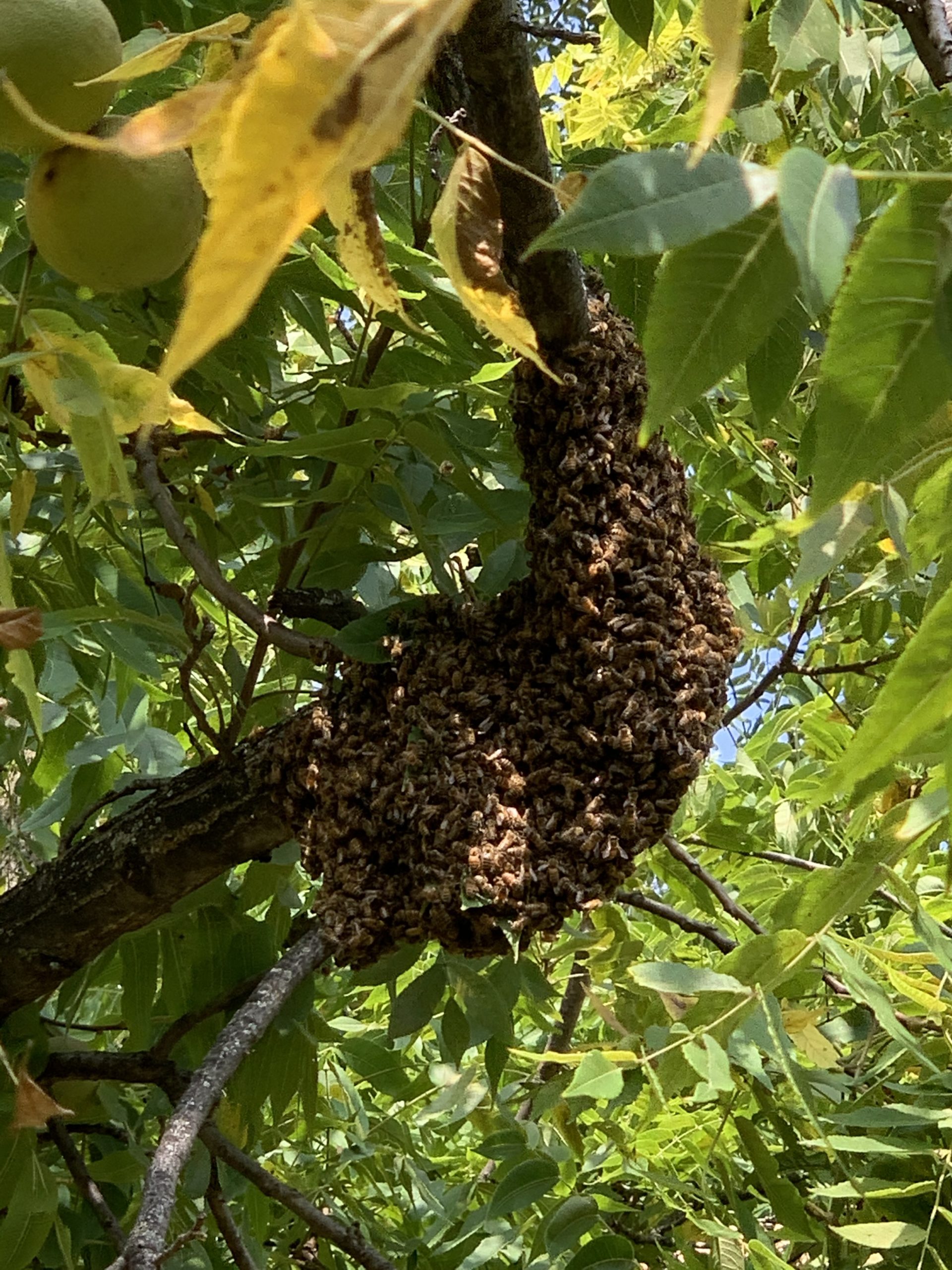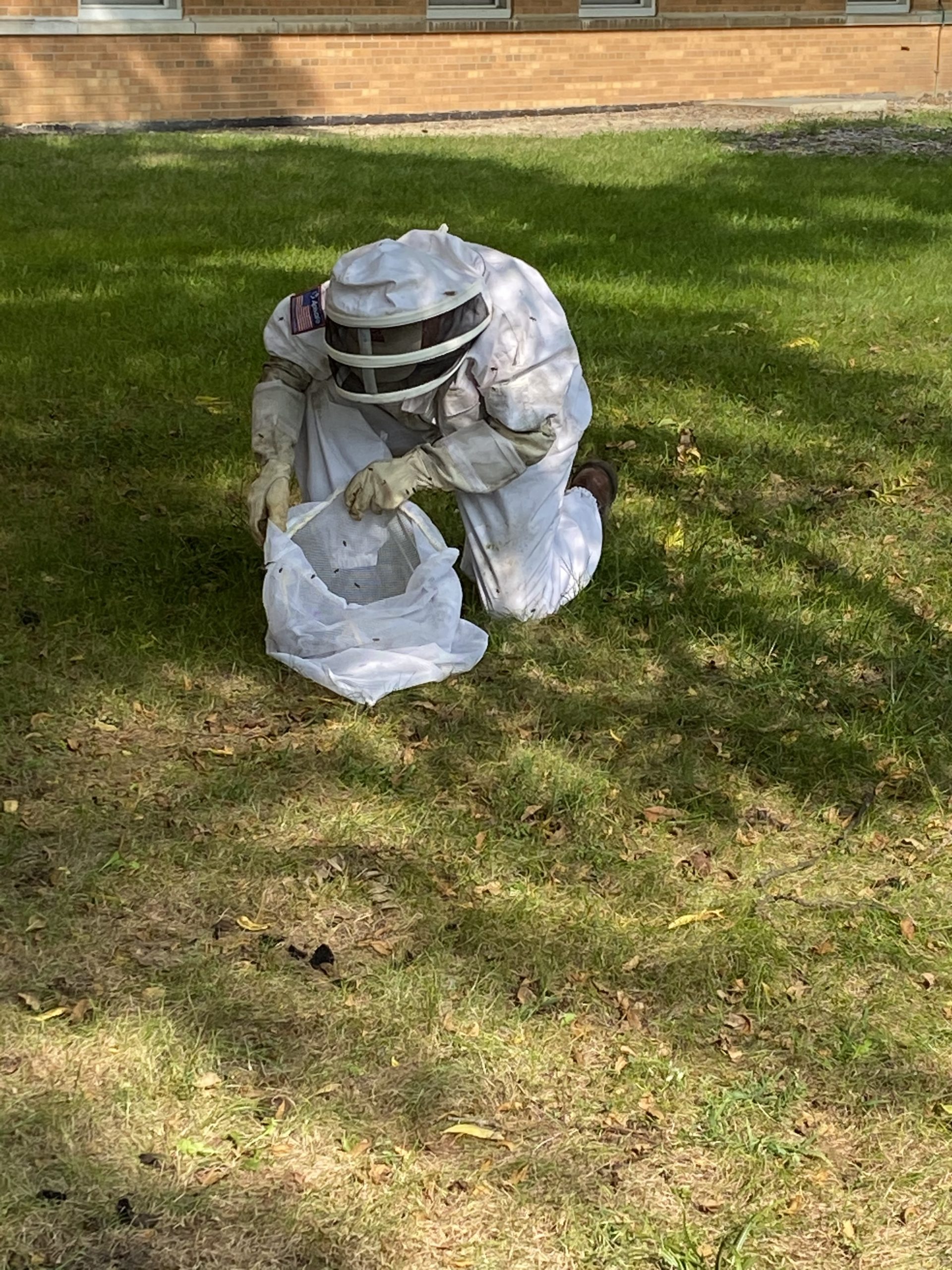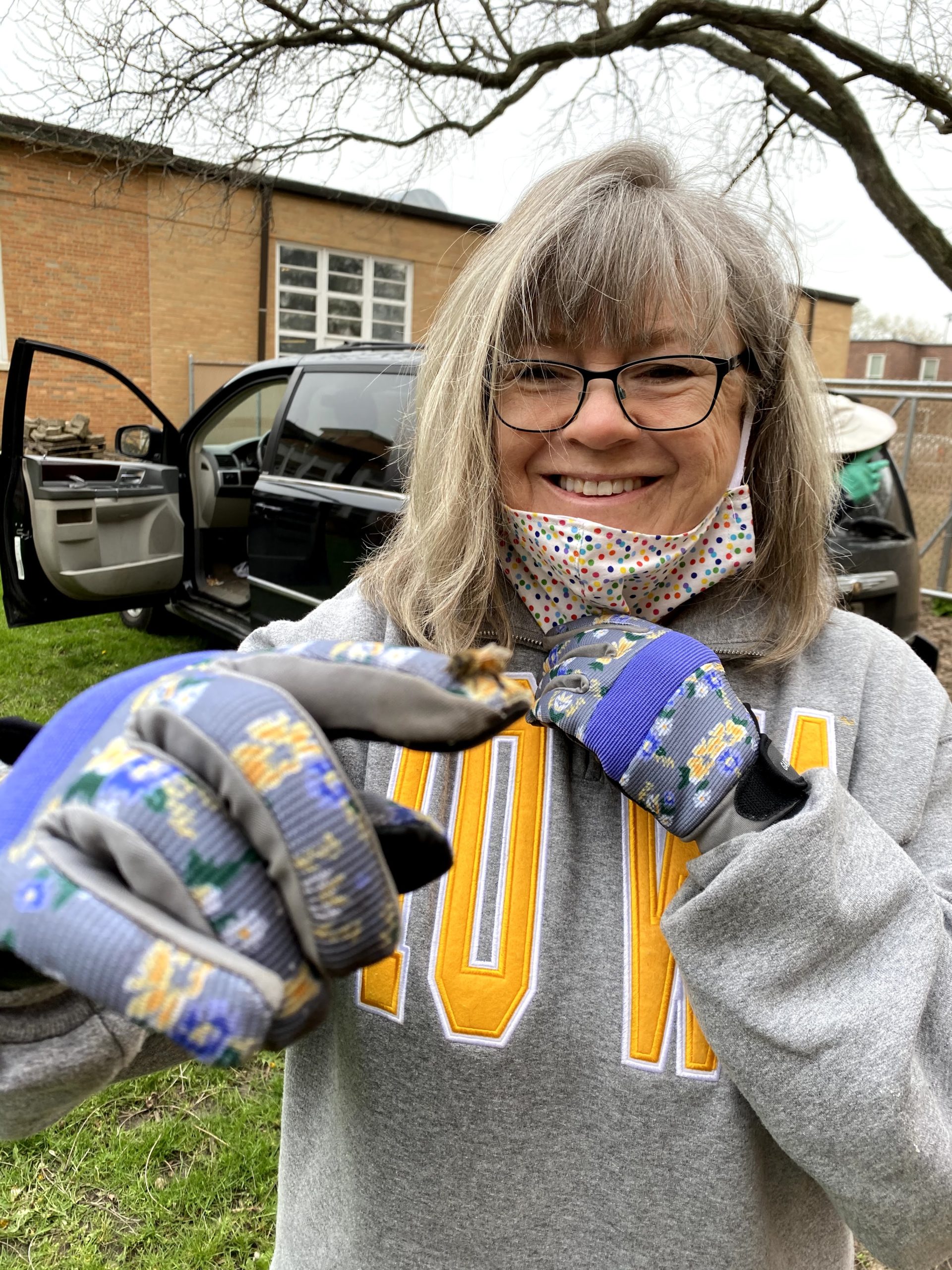 In mid-September, Mary Krystinak, Director Our Lady of Angels and Sisters Healthy Living, received an urgent email reporting, “The Bees are Swarming!” The email included pictures of hundreds of bees in a cluster, hanging pendulously from a branch above the current beehive.
In mid-September, Mary Krystinak, Director Our Lady of Angels and Sisters Healthy Living, received an urgent email reporting, “The Bees are Swarming!” The email included pictures of hundreds of bees in a cluster, hanging pendulously from a branch above the current beehive.
Fortunately, Mary was in route to the OLA gardens for her weekly visit. She called our beekeeper, Alphonse Scepurek, to advise him of the emergency. You may recall that earlier this year, only a few weeks after the installation of our new hive, we experienced a swarm, and we did not arrive in time to discourage the bees from leaving. The initial hive “flew the coup” or shall we say, “flew the hive.” Mary and Alphonse were concerned about losing another colony of bees.
Mary arrived in time to see a large swarm of bees hanging from the tree branch as described. Al called to let Mary know he was on his way and that she needed to stop the bees from leaving. Al asked Mary to get a pot and lid and clang them beneath the swarm. Mary writes, “So here I was, like a crazy woman, moving around under a tree, gazing upwards and banging my pot and lid.” This is known as “tanging.” Al had advised Mary that it would calm the bees until he arrived. Some experts say it works, and others say it is just folklore; in this case the bees decided to stay.

Al arrived and determined that this “swarm” was not our colony from the hive, but a new swarm that had lost their home. This swarm of homeless bees was scouting a new location for their home. Mary helped Al into his beekeeping suit. Ray Ward procured a ladder, which was leaned on a branch 12 feet high. Al proceeded toward the swarm with a large mesh bag that he intended to put over the swarm and then shake them into the bag. Mary writes,
“For those of you who know Al (he is an old friend of Sr. Alice Reckamp and Sr. Martha) know he is no spring chicken. I was worried about him falling off the ladder. So instead of taking pictures of this process, I was holding onto the ladder to keep it steady. Also, Al advised that if they decided to come for me to be ready to head to my car. I was praying a lot of Hail Mary’s and asking the bees to please not attack me – because I was not going to abandon Al on the ladder.”
After a very tense 5 minutes, Al had captured most of the bees and descended the ladder. There was still a good portion clinging to the tree that he wanted in the bag. To capture the remaining bees, he left the bag hanging on the ladder. He went to get dinner and returned at sunset to find all the stray bees clustered on the outside of the bag. Placing a spare mesh bag over this bee-filled bag, Al was able to capture the entire swarm to take home and begin a new hive. The hard work paid off, and Al was able to

replace the hive he had lost in the spring.
Our OLA bees are all safe and continue pollinating our garden. After storing up enough honey to keep themselves going for the winter, our hope is that there will be some left over for us to enjoy.
[fusion_gallery layout=”” picture_size=”” columns=”3″ column_spacing=”5″ gallery_masonry_grid_ratio=”” gallery_masonry_width_double=”” hover_type=”” lightbox=”yes” lightbox_content=”” bordersize=”” bordercolor=”” border_radius=”” hide_on_mobile=”small-visibility,medium-visibility,large-visibility” class=”” id=””][fusion_gallery_image image=”https://wheatonfranciscan.org/wp-content/uploads/2020/05/IMG_0267-scaled.jpg” image_id=”4741″ link=”” linktarget=”_self” /][fusion_gallery_image image=”https://wheatonfranciscan.org/wp-content/uploads/2020/05/IMG_0265-scaled.jpg” image_id=”4739″ link=”” linktarget=”_self” /][fusion_gallery_image image=”https://wheatonfranciscan.org/wp-content/uploads/2020/05/IMG_0269-1-scaled.jpg” image_id=”4743″ link=”” linktarget=”_self” /][fusion_gallery_image image=”https://wheatonfranciscan.org/wp-content/uploads/2020/05/IMG_0270-1-scaled.jpg” image_id=”4744″ link=”” linktarget=”_self” /][fusion_gallery_image image=”https://wheatonfranciscan.org/wp-content/uploads/2020/05/IMG_0271-scaled.jpg” image_id=”4745″ link=”” linktarget=”_self” /][fusion_gallery_image image=”https://wheatonfranciscan.org/wp-content/uploads/2020/05/IMG_0272-scaled.jpg” image_id=”4746″ link=”” linktarget=”_self” /][/fusion_gallery]
Introducing the Beehive in Our Lady of the Angels Lower Garden
Alphonse Scepurek contacted me early this year to discuss the possibility of having one of his beehives located on our property. The agreement would be that he would tend the bees, harvest the honey, and then share half of the honey with the Sisters.
Al and his wife Mary have been longtime friends of Sr. Martha Friedman, Sr. Alice Reckamp and Covenant Companion Brother Harry DeGrave. At our initial meeting on March 5. 2020, Sr. Martha and Sr. Alice joined me and Al for a lesson the on basics of beekeeping.
The bee colony and queen arrived from Georgia at the beginning of April. He purchased 3 pounds of worker bees, approximately 10,000, along with one queen bee who has already been mated. The queen bee has her own special cage within the shipment of bees. She remained in the cage for approximately one week, giving the colony time to decide if they want this queen.
After the initial week of getting to know each other, Al returned to remove the queen’s small cage. Her cage comes with a stopper to keep her inside. Al removes the stopper and, in its place, puts a marshmallow. Now the bees need to work to get their queen. They will eat through the marshmallow releasing her into their colony.
Once the queen is released, she takes up permanent residence in the hive. She will never leave the hive for the rest of her life. The bees will feed her and in turn she will lay eggs. Her court of worker bees (all female) will escort her to the area they have prepared for egg laying. Each egg is then carefully placed by the worker bees into its own cell and covered with royal jelly. These eggs will all grow into more female worker bees. A queen bee will live up to 4 years, or as long as she produces eggs. Each queen can lay 1000 – 2000 eggs per day.
Each level of the hive has approximately 10 trays. Al has 5 of them prebuilt with honeycomb. The other trays will be constructed by the bees. Some of the combs are used for raising bees, some for their winter food storage and some for honey harvest.
Al filled some of the trays with a sugar water to sustain the bees until the warmer weather and blossoming trees and flowers.
After all this work, the first queen decided for some reason that she did not like the hive and decided to leave. When a queen leaves, she takes the entire colony with her to start over somewhere else. Ray Ward and Jack DeRose found the swarm of bees and notified Al to come and get them back in the hive. But by the time Al arrived, they had all left. So…Al had to start over with a new queen and 3 pounds of bees. Hopefully, this new queen will be happy with her hive and decide to stay, take up residence and provide us with many more honeybees and some delicious honey.
For in-depth information on the life of a queen bee:
[fusion_gallery layout=”” picture_size=”” columns=”” column_spacing=”10″ gallery_masonry_grid_ratio=”” gallery_masonry_width_double=”” hover_type=”” lightbox=”yes” lightbox_content=”” bordersize=”” bordercolor=”” border_radius=”” hide_on_mobile=”small-visibility,medium-visibility,large-visibility” class=”” id=””][fusion_gallery_image image=”” image_id=”4076″ /][fusion_gallery_image image=”” image_id=”4074″ /][fusion_gallery_image image=”” image_id=”4073″ /][fusion_gallery_image image=”” image_id=”4072″ /][fusion_gallery_image image=”” image_id=”4075″ /][fusion_gallery_image image=”” image_id=”4026″ /][/fusion_gallery]
Click Here For More Information On The Importance Of Bees

